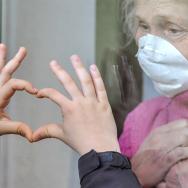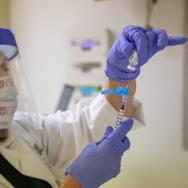Nearly a year ago, schools across the United States and the rest of the world closed in response to the start of the COVID-19 pandemic.
Since then, many children have had to navigate various forms of non-traditional learning, from virtual classrooms to limited in-person settings. According to Prof. Lainie Friedman Ross of the University of Chicago Medicine, the costs of K-12 school closures are borne disproportionately by students, families and school personnel from vulnerable populations—many of whom rely on schools for resources other than learning.
In a recent paper, Ross collected state-level documents and examined them for mentions of equity issues such as food insecurity, homelessness and access to internet and technology. She co-authored the research with Alice Li, a student at the Pritzker School of Medicine, and UChicago Medicine pediatric resident Michael Harries.
A leading pediatrician who specializes in clinical medical ethics, Ross also discussed the impact of K-12 school closures during a Jan. 22 virtual event hosted by the Mansueto Institute for Urban Innovation as part of the Trauma Interest Working Group Speaker Series. Parts of that talk are highlighted below.
How much do school closures limit COVID-19?
“[By March 27, 2020, we had] 1.5 billion children around the globe, which is 87% of all the children on Earth, who were affected by school closure because of COVID-19—just an unprecedented idea,” said Ross, the Carolyn and Matthew Bucksbaum Professor of Clinical Medical Ethics. “These were based on evidence and assumptions from influenza outbreaks, because in influenza—[for] which children are often known to be super spreaders—by closing the schools, it was known that we could interrupt the transmission. It was not known whether this would also happen with regard to COVID-19. And in fact, the data nine months later—whether this holds for COVID-19 and K-12 schools—were less compelling.”
Ross then discussed examples from different parts of the world, including Taiwan—which was able to limit transmission while schools remained open—and France, which found limited evidence of secondary transmission within primary schools, but more spread within certain high schools. Models in the United Kingdom, she added, showed that school closures may have helped less than interventions such as masking, hand-washing and social distancing.
Some studies in the U.S. have associated school closures with decreases in COVID-19, but those changes may have also coincided with local mask-wearing mandates.
“The data are all over the place,” Ross said. “It makes it hard to make good policy when your evidence is mixed and ambiguous.”
Why schools are so important
As the COVID-19 pandemic took hold, schools around the world took different measures to incorporate virtual learning. Ross cited a survey from UNESCO, UNICEF and the World Bank showing that although three-quarters of countries counted remote learning days as official school days, this was only true for a fifth of low-income country respondents.
“When we look at the gaps, what we’re seeing is that the wealthier countries where there was much greater access to internet were being more effective and more able to use virtual learning techniques,” Ross said.
Overall, the survey showed that 108 countries reported missing an average of 47 days of in-person instruction due to school closures, roughly a quarter of a regular school year. Furthermore, one in four high-income countries were not introducing additional support measures for remote learning—suggesting that school closures could widen achievement gaps even in places like the United States.
Ross also stressed that, as vital as schools are as places of learning, their value also extends beyond pedagogy—particularly for low-income, minority communities.
“Other than just teaching our children, they’re the source of child care which allows parents to work,” Ross said. “They’re the source of food. They’re a source of safety. They’re a source of mental health promotion. They're a source of exercise and physical well-being.”
Steps to reopening
Because COVID-19 vaccines have not yet been approved for use in young children, the health and safety of those students—as well as their families—will depend on the vaccination of those around them, including teachers and other school workers.
“There are no data yet on vaccinating the children,” Ross said. “The only way to protect the children and to protect the teachers is for the teachers to protect themselves.”
Although the risk of transmission from young children to high-risk family members is relatively low, Ross also acknowledged that the risk is not zero. And because racial minorities often face higher risks with COVID-19 infections, plans to reopen schools should also take into account issues of equity.
Due to the high costs of missed schooling, Ross advocates for reopening schools before a COVID-19 vaccine is widely administered to children. However, she stressed that policymakers need to consider both voluntary and mandatory mitigation strategies—including mask-wearing—and reassess public priorities, both now and for future pandemics.
“If there’s a certain amount of exposure that we need to tolerate in order to start reopening things, I would have argued that I would have put schools before restaurants and bars,” Ross said.

